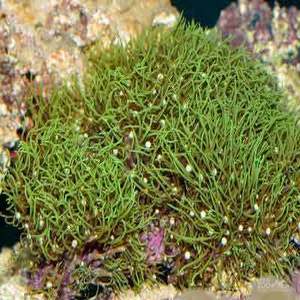 Green Star Polyps have a bright purple to reddish colored mat and very green, yellow, or light green tentacles. The mats are flat by irregular. They are robust and will spread easily. Green Star Polyps form stolons that are connected forming a mesh-like structure with all the polyps being housed in tubular calyces. There are 8 bold tentacles to a polyp that are thin and smooth. The tentacles surround a center opening, or mouth, that is often another contrasting color.The polyps are generally expanded unless an outside stimuli disturbs them, then they can retract fully.
Green Star Polyps have a bright purple to reddish colored mat and very green, yellow, or light green tentacles. The mats are flat by irregular. They are robust and will spread easily. Green Star Polyps form stolons that are connected forming a mesh-like structure with all the polyps being housed in tubular calyces. There are 8 bold tentacles to a polyp that are thin and smooth. The tentacles surround a center opening, or mouth, that is often another contrasting color.The polyps are generally expanded unless an outside stimuli disturbs them, then they can retract fully.
Location: Animals Formerly at Zoo
Share:
Range
Indo-Pacific oceans
Habitat
They are found along upper reef edges and lagoons, in shallow waters to moderate depths. They are common on inshore reefs and reef flats where there is more water flow.
Conservation Status
Primary Threats
Gestation
They can grow about 1” a month in optimal conditions.
Litter
The amount of daughter polyps formed depend on the condition of the mat and amount of light and nutrients in the water surrounding the polyps.
Behavior
They are aggressive and can cover over other corals, but also are at risk of being stung. They prefer moderate to strong turbulent water flow to remove detritus and to help with polyp expansion.
Reproduction
The polyps will form daughter polyps from the edge of their mat.
Wild Diet
These corals can absorb dissolved organic matter from the water column and have a symbiotic relationship with marine algae known as zooxanthellae, where they also receive some of their nutrients.
Zoo Diet

